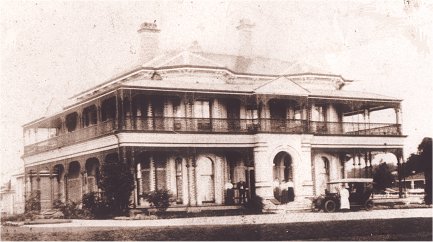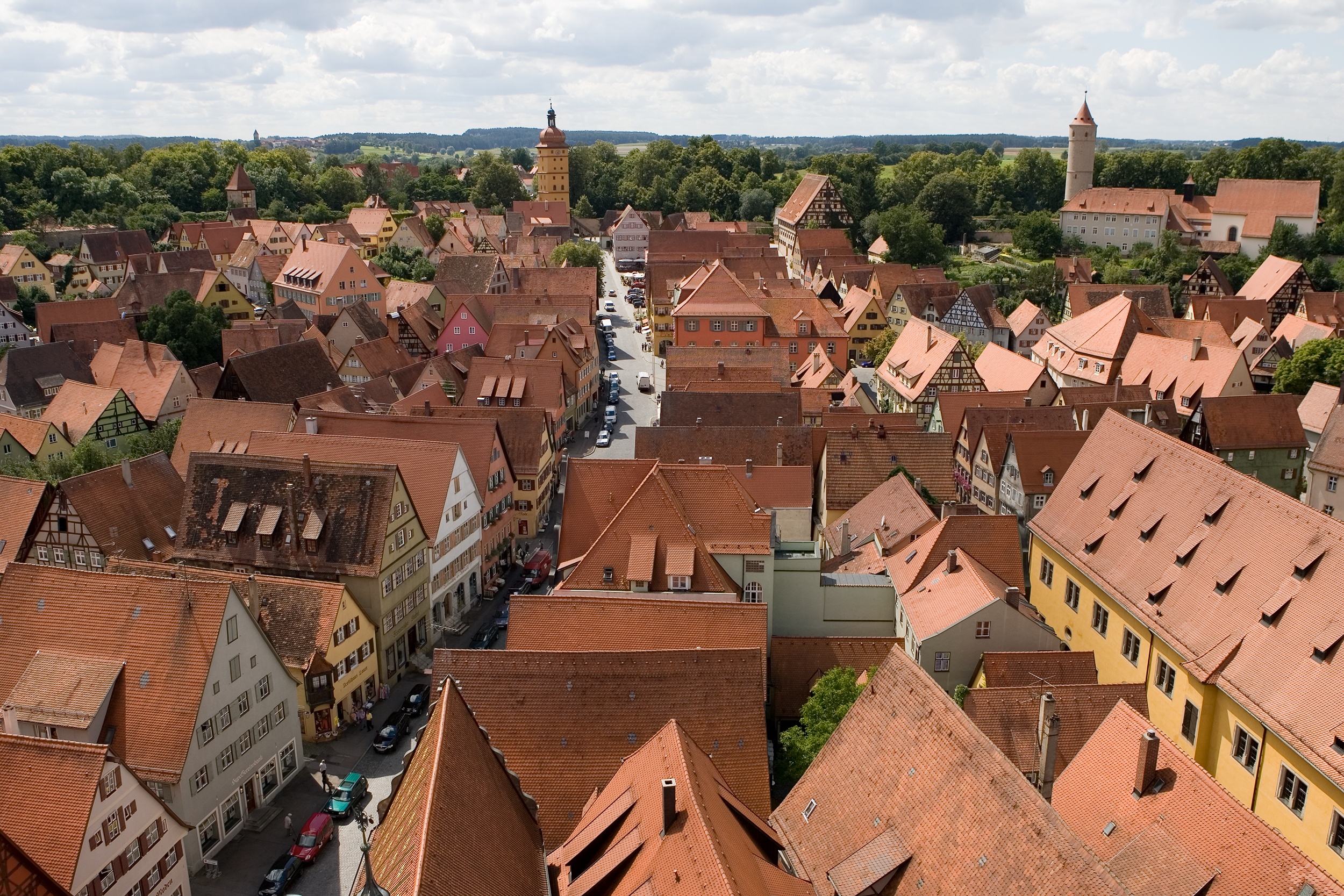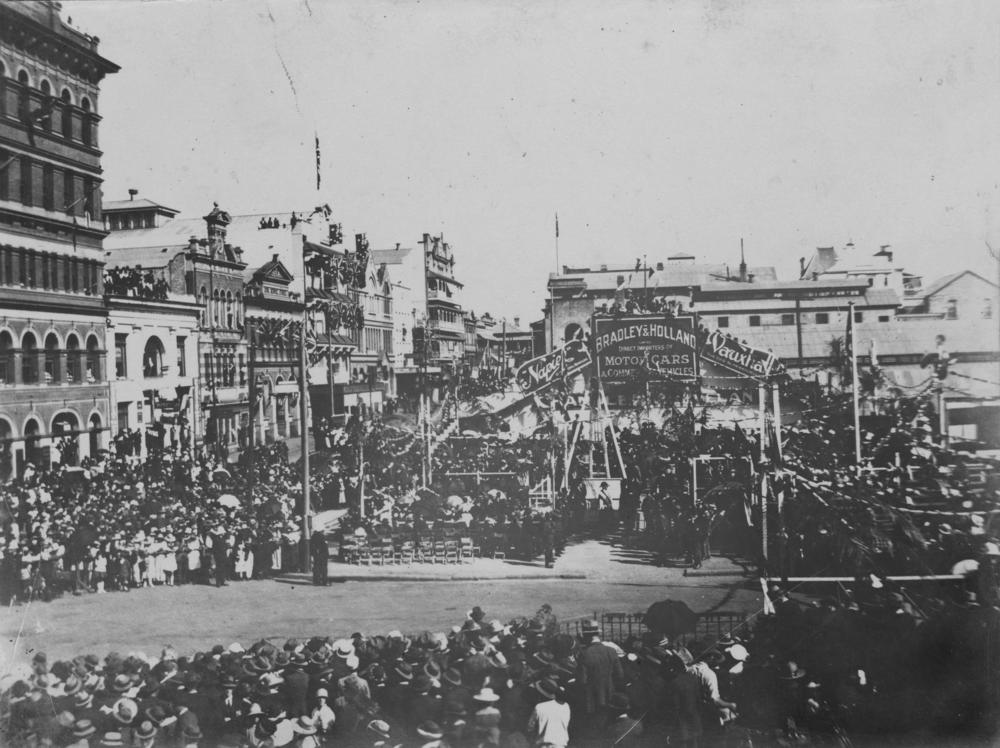|
Musket Villa
Musket Villa is a heritage-listed detached house at 251 Lancaster Road, Ascot, Queensland, Australia. It was designed by architectural firm Hall and Prentice and was built in 1923. It is also known as Lancaster Gables. It was added to the Queensland Heritage Register on 28 July 2000. History Musket Villa, a single storey, stucco interwar bungalow and the adjoining stables were constructed in 1923 for well-known horse trainer and rider, William "Billy" Booth. Located opposite Eagle Farm Racecourse in Lancaster Road, Musket Villa was designed by prominent Brisbane architects Hall and Prentice and built by contractors Lee and Brickwood. William Booth entered the horse training and racing industry in 1885 when he became an apprentice to John Stone, an early Brisbane horse trainer. During his nine years with Stone, Booth trained and rode many famous horses. His work included breaking-in Grey Gown and training Dundonald who went on to win the treble of St. Ledger, the Brisbane ... [...More Info...] [...Related Items...] OR: [Wikipedia] [Google] [Baidu] |
Ascot, Queensland
Ascot is a north-east suburb in the City of Brisbane, Queensland, Australia. In the , Ascot had a population of 5,777 people. Geography Ascot is characterised by large Queenslander homes and is located approximately north-east of Brisbane GPO. Ascot is best known for its beautiful old homes, the picturesque poinciana tree lined shopping area of Racecourse Road (), and for the Eagle Farm () and Doomben () racecourses popular for racing carnivals. Over a third of the suburb is taken up by Doomben and its related outer buildings, Eagle Farm and Doomben racecourses. Bartleys Hill is in the south-west of the suburb () and is above sea level. History Historically, the land was occupied by the Aboriginal Turrbal clan. The Turrbal called the area Yowoggerra, meaning ''corroboree place''. The clan had camping grounds on the north side of the Brisbane River around the Breakfast Creek area. It was at Breakfast Creek that explorers Oxley and Cunningham met members of the clan i ... [...More Info...] [...Related Items...] OR: [Wikipedia] [Google] [Baidu] |
Racecourse Road, Brisbane
Racecourse Road is a road in the suburb of Hamilton in the City of Brisbane, Queensland, Australia. It is a dining, shopping and entertainment precinct in Brisbane, that connects Kingsford Smith Drive and the Eagle Farm Racecourse. Geography Racecourse Road extends for from Kingsford Smith Drive in Hamilton in the south to Eagle Farm Racecourse in Ascot in the north. At its southern end, it connects to Portside Wharf and the Hamilton Harbour precinct, at its northern end to the Doomben Racecourse. The road is well known for the poinciana trees lining the footpaths along its full length. Transport Racecourse Road was serviced by a Brisbane tram line from 1899 until 1969 when all Brisbane tram services were abandoned. It is now serviced by four stops of Brisbana bus lines 300 and 305, as well as lines 301, 302 and 303. TransLink's CityCat terminal is located the road's southern end at Bretts Wharf. Access to the City network train services is provided since 1882 by the E ... [...More Info...] [...Related Items...] OR: [Wikipedia] [Google] [Baidu] |
Gable
A gable is the generally triangular portion of a wall between the edges of intersecting roof pitches. The shape of the gable and how it is detailed depends on the structural system used, which reflects climate, material availability, and aesthetic concerns. The term gable wall or gable end more commonly refers to the entire wall, including the gable and the wall below it. Some types of roof do not have a gable (for example hip roofs do not). One common type of roof with gables, the gable roof, is named after its prominent gables. A parapet made of a series of curves (Dutch gable) or horizontal steps (crow-stepped gable) may hide the diagonal lines of the roof. Gable ends of more recent buildings are often treated in the same way as the Classic pediment form. But unlike Classical structures, which operate through trabeation, the gable ends of many buildings are actually bearing-wall structures. Gable style is also used in the design of fabric structures, with varying degree ... [...More Info...] [...Related Items...] OR: [Wikipedia] [Google] [Baidu] |
Marseilles Tile
Roof tiles are designed mainly to keep out rain, and are traditionally made from locally available materials such as terracotta or slate. Modern materials such as concrete, metal and plastic are also used and some clay tiles have a waterproof glaze. Roof tiles are 'hung' from the framework of a roof by fixing them with nails. The tiles are usually hung in parallel rows, with each row overlapping the row below it to exclude rainwater and to cover the nails that hold the row below. There are also roof tiles for special positions, particularly where the planes of the several pitches meet. They include ridge, hip and valley tiles. These can either be bedded and pointed in cement mortar or mechanically fixed. Similarly to roof tiling, tiling has been used to provide a protective weather envelope to the sides of timber frame buildings. These are hung on laths nailed to wall timbers, with tiles specially molded to cover corners and jambs. Often these tiles are shaped at the exposed ... [...More Info...] [...Related Items...] OR: [Wikipedia] [Google] [Baidu] |
Musket Villa Entrance
A musket is a muzzle-loaded long gun that appeared as a smoothbore weapon in the early 16th century, at first as a heavier variant of the arquebus, capable of penetrating plate armour. By the mid-16th century, this type of musket gradually disappeared as the use of heavy armour declined, but ''musket'' continued as the generic term for smoothbore long guns until the mid- 19th century. In turn, this style of musket was retired in the 19th century when rifled muskets (simply called rifles in modern terminology) using the Minié ball (invented by Claude-Étienne Minié in 1849) became common. The development of breech-loading firearms using self-contained cartridges (introduced by Casimir Lefaucheux in 1835) and the first reliable repeating rifles produced by Winchester Repeating Arms Company in 1860 also led to their demise. By the time that repeating rifles became common, they were known as simply "rifles", ending the era of the musket. Etymology According to the Online ... [...More Info...] [...Related Items...] OR: [Wikipedia] [Google] [Baidu] |
Tattersalls Club
Tattersalls Club is a heritage-listed club house at 206 Edward Street (with a second frontage on Queen Street), Brisbane City, Queensland, Australia. It was designed by Hall and Prentice and built from 1925 to 1949. It was added to the Queensland Heritage Register on 21 October 1992. History These clubrooms were constructed for the Tattersalls Club of Brisbane in 1925–26, with extensions in 1938–39 and 1949. Tattersalls Club was formed in November 1883, following the model of sporting clubs established in Britain. It was particularly concerned with horse racing, and the club held its first race meeting in 1884. Tattersalls Club met in the Australian Hotel at the corner of Queen and Albert Streets from 1883 until 1888 and then subsequently leased various premises as its clubrooms. Tattersalls made several inner city property investments, the sale of which financed the acquisition of a site in Edward Street for new clubrooms, as well as a right-of-way to Queen Stree ... [...More Info...] [...Related Items...] OR: [Wikipedia] [Google] [Baidu] |
Sandgate Town Hall
Sandgate Town Hall is a heritage-listed town hall at 5 Brighton Road, Sandgate, City of Brisbane, Queensland, Australia. It was designed by Thomas Ramsay Hall and built from 1911 to 1912 by John Gemmell. It was added to the Queensland Heritage Register on 13 January 1995. History The Sandgate Town Hall was constructed in 1911–1912 when the previous chambers were destroyed by fire on 24 May 1910. The architect of the hall, which cost £5000, was Thomas Ramsay Hall, and the contractor John Gemmell. Britons first settled in Sandgate in the 1850s, and the area prospered into the following century as the principal sea-side resort in south east Queensland, encouraged by the introduction of the railway in May 1882. The Town of Sandgate was established in 1902, previously included as part of the Nundah Division from 1879, then established as a separate Borough of Sandgate in April 1880. The first Municipal Council meetings from 1880 until 1882 were held in a large room rented ... [...More Info...] [...Related Items...] OR: [Wikipedia] [Google] [Baidu] |
Brisbane City Hall
Brisbane City Hall, in Brisbane, Queensland, Australia, is the seat of the Brisbane City Council. It is located adjacent to King George Square, where the rectangular City Hall has its main entrance. The City Hall also has frontages and entrances in both Ann Street and Adelaide Street. The building design is based on a combination of the Roman Pantheon, and St Mark's Campanile in Venice and is considered one of Brisbane's finest buildings. It was listed on the Register of the National Estate in 1978 and on the Queensland Heritage Register in 1992. It is also iconic for its Westminster chimes which sound on the quarter-hour. The building has been used for royal receptions, pageants, orchestral concerts, the Lord Mayor's Seniors Christmas Concerts, civic greetings, flower shows, school graduations and political meetings. In 2008, it was discovered that the building had severe structural problems. After a three-year restoration, it re-opened on 6 April 2013. History The City Hal ... [...More Info...] [...Related Items...] OR: [Wikipedia] [Google] [Baidu] |
George Gray Prentice
George Gray Prentice (25 July 1891 – July 1944) was an architect practising in Brisbane, Australia, during the first half of the twentieth century and was involved in the design and construction of numerous major buildings in South East Queensland including the Queensland Heritage Register listed Brisbane City Hall. Life G. G. Prentice was born on 25 July 1891 in Tank Street, Brisbane, Queensland and was the son of George Prentice, first mayor of Sandgate and director of the Brisbane Permanent Building and Banking Company, and his second wife Jean Elizabeth, née Gray, daughter of a pioneering boot retailer Messrs. T. and W. Gray's in George Street, Brisbane. George's half-sister, Jessie Blanche (aged 18), and paternal grandfather, George Prentice (aged 70), died the year before his birth when the was wrecked on the Far North Queensland coast in 1890. He attended the Normal School in Brisbane, and was an employee in the artist's department of Watson, Ferguson and Compa ... [...More Info...] [...Related Items...] OR: [Wikipedia] [Google] [Baidu] |
Thomas Ramsay Hall
Thomas Ramsay Hall (2 January 1879 – 15 December 1950) was an architect practicing in Brisbane, Australia, during the first half of the twentieth century and was involved in the design and construction of numerous major buildings in South East Queensland including the Queensland Heritage Register listed Brisbane City Hall. Life Thomas Ramsay Hall was born on 2 January 1879 and was the son of John R Hall, one of Brisbane's early architects, and his third wife Charlotte, née Whiteway. Thomas was the younger half-brother of Francis Richard Hall who was the oldest practicing architect in Australia at the time of his own death in 1939. Hall attended Brisbane Grammar School from 1891 where he won the Francis memorial prize for mathematics. After graduation, he studied accountancy, architecture and became an approved valuer. From 1907 he was town clerk for Sandgate Council. On 9 March 1910 he married Emma Lingley at St Nicholas's Church, Sandgate. The couple had four child ... [...More Info...] [...Related Items...] OR: [Wikipedia] [Google] [Baidu] |
Queensland Turf Club
The Queensland Turf Club (QTC) was founded in August 1863. It began on a piece of land in Ascot, Queensland, later called Eagle Farm Racecourse, given to the club by government grant. The first meeting of the club was held on 14 August 1865. Some of the major races staged today by the QTC are the Brisbane Cup, Queensland Derby, The QTC Cup, The T. J. Smith handicap, The Sires produce, and Queensland's greatest race the Stradbroke Handicap. Some other races held at the QTC are the Sir Edward Williams handicap, P. O'Shea stakes, Peter Gallagher, Sir Byrne Hart stakes. On 1 July 2009, the Queensland Turf Club merged with the Brisbane Turf Club (BTC) to form the Brisbane Racing Club (BRC); the BTC had run until then the nearby Doomben Racecourse Doomben Racecourse is a horse racing venue in Brisbane, Queensland, Australia. It is located in the suburb of Ascot, 7 kilometres north of the Brisbane central business district. The Doomben course neighbours another thoroughbred ... [...More Info...] [...Related Items...] OR: [Wikipedia] [Google] [Baidu] |
Queensland
) , nickname = Sunshine State , image_map = Queensland in Australia.svg , map_caption = Location of Queensland in Australia , subdivision_type = Country , subdivision_name = Australia , established_title = Before federation , established_date = Colony of Queensland , established_title2 = Separation from New South Wales , established_date2 = 6 June 1859 , established_title3 = Federation , established_date3 = 1 January 1901 , named_for = Queen Victoria , demonym = , capital = Brisbane , largest_city = capital , coordinates = , admin_center_type = Administration , admin_center = 77 local government areas , leader_title1 = Monarch , leader_name1 = Charles III , leader_title2 = Governor , leader_name2 = Jeannette Young , leader_title3 = Premier , leader_name3 = Annastacia Palaszczuk ( ALP) , legislature = Parliament of Queensland , judiciary = Supreme Court of Queensland , national_representation = Parliament of Australia , national_representation_type ... [...More Info...] [...Related Items...] OR: [Wikipedia] [Google] [Baidu] |







